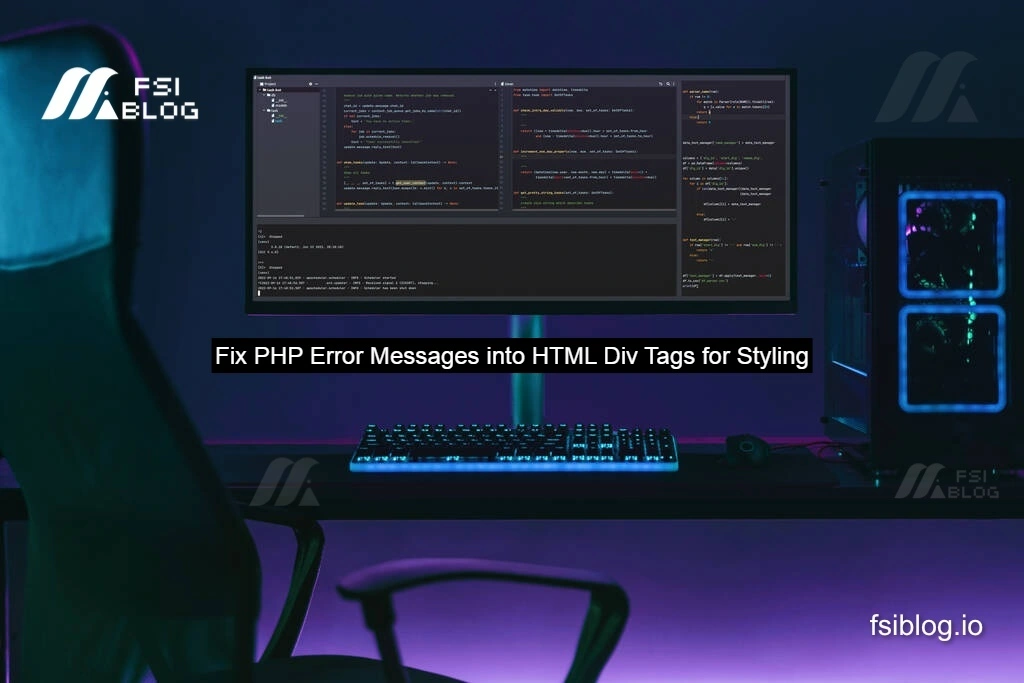Fix PHP Error Messages into HTML Div Tags for Styling

To define the error message within the <div> tag in a paragraph form, you can move the PHP “Login Failed” message into an HTML <div> by modifying the PHP code and adding a condition to display it within the <div class="login-error">.
To move the Login Failed message into a div tag within the HTML layout, you can modify the PHP code to echo the message inside a div with the class login-error. This way, the error message will display within the designated area in the HTML layout. Here’s the adjusted code:
Error Code:
code<?php
// Assume this block is part of your login logic.
$error_message = ""; // Initialize error message variable
if (/* login successful condition */) {
header("Location: private.php");
die("Redirecting to: private.php");
} else {
$error_message = "Login Failed."; // Set error message when login fails
}
?>
<html>
<head>
<meta http-equiv="Content-Type" content="text/html; charset=utf-8">
<title>Untitled Document</title>
<link rel="stylesheet" type="text/css" media="screen" href="css/style.css">
</head>
<body>
<div id="container">
<div id="header-main">Main Menu</div>
<div id="header"></div>
<div id="content">
<div class="table">
<div class="tr">
<div id="member" class="td" align="center">
<span class="member">Data</span>
</div>
<div class="vr"> </div>
<div id="login" class="td">
<div class="login-error">
<?php echo $error_message; ?> <!-- Error message displayed here -->
</div>
<div class="login-title">LogIn</div>
<form action="login.php" method="post">
<input type="text" name="username" value="<?php echo $submitted_username; ?>" placeholder="Username" autofocus/>
<br /><br />
<input type="password" name="password" value="" placeholder="Password"/>
<br /><br />
<input type="submit" value="Login" />
</form>
</div>
</div>
</div>
</div>
</div>
</body>
</html>
To move the “Login Failed” message into the <div class="login-error"> div, we can use a PHP variable to store the error message when the login fails, then display that variable in the HTML. Here’s how to implement this solution:
Display the error message inside the <div class="login-error"> in the HTML by echoing the PHP variable.
Initialize a PHP variable for the error message, setting it as an empty string initially.
Set the error message within the else block when the login fails.
Correct Code:
code<?php
// Existing login logic
if (/* login successful condition */) {
header("Location: private.php");
die("Redirecting to: private.php");
} else {
$error_message = "Login Failed."; // Store the error message in a variable
}
?>
<html>
<head>
<meta http-equiv="Content-Type" content="text/html; charset=utf-8">
<title>Untitled Document</title>
<link rel="stylesheet" type="text/css" media="screen" href="css/style.css">
</head>
<body>
<div id="container">
<div id="header-main">Main Menu</div>
<div id="header"></div>
<div id="content">
<div class="table">
<div class="tr">
<div id="member" class="td" align="center">
<span class="member">Data</span>
</div>
<div class="vr"> </div>
<div id="login" class="td">
<?php if (!empty($error_message)) : ?>
<div class="login-error"><?php echo $error_message; ?></div>
<?php endif; ?>
<div class="login-title">LogIn</div>
<form action="login.php" method="post">
<input type="text" name="username" value="<?php echo htmlspecialchars($submitted_username); ?>" placeholder="Username" autofocus/>
<br /><br />
<input type="password" name="password" value="" placeholder="Password"/>
<br /><br />
<input type="submit" value="Login" />
</form>
</div>
</div>
</div>
</div>
</div>
</body>
</html>
Explanation:
- Error Message in
div: The$error_messagevariable holds the login failure message. It is only displayed if it has a value. - Sanitized Output:
htmlspecialchars($submitted_username)ensures that any special characters in$submitted_usernameare safely displayed in the input field. - HTML Structure: The error message displays within
<div class="login-error">so that it appears in the intended place within the HTML layout.
Final Thought:
In the end, managing user experience with clear and intuitive error handling is crucial for any application. By placing error messages directly within the context of the login form, we enhance user guidance, making it easy to spot issues and encouraging quick corrections. With this small change, we improve both usability and the overall flow, creating a more seamless and supportive interaction for users. Thoughtful design and precise coding choices like these build a more accessible and user-friendly interface.
